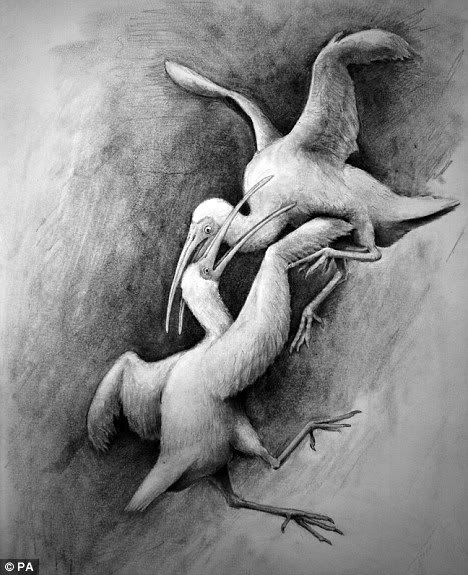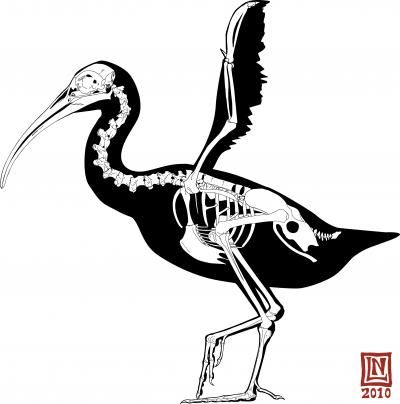Post by Melanie on Nov 7, 2005 17:11:05 GMT
Deletion of the Flightless Ibis Xenicibis
from the Fossil Record of Cuba
WILLIAM SUA´ REZ Museo Nacional de Historia Natural;
Obispo 61, Plaza de Armas, La Habana CH 10100, Cuba.
geopal@mnhnc.inf.cu
Shortly after the discovery of the first known flightless
ibis Apteribis glenos (Olson and Wetmore, 1976) in
the Hawaiian islands (augmented later by a second
species A. brevis Olson and James, 1991), the equally
remarkable flightless ibis Xenicibis xympithecus (Olson
and Steadman, 1977) was described from Jamaica. The
description was based on some postcranial elements
collected by H. E. Anthony during 1919-1920 in a cave
deposit at Long Mile Cave, Trelawny Parish, Jamaica,
and was followed by the description of a complete and
well preserved humerus from Swansea Cave, St.
Catherine Parish, Jamaica (Olson and Steadman,
1979).
That Xenicibis might have been more widely distributed
was suggested by Acevedo-Gonza´les and Arredondo
(1982), who recorded the genus from Cuba
without mentioning localities or specimens. Arredondo
(1984:6-7) then referred to “Xenicibis sp.” a
complete left humerus that he collected in Cueva de
Pý´o Domingo, Sumidero, Pinar del Rý´o, and kept in his
private collection (OA 2969). He also noted some other
appendicular elements of “Xenicibis sp.”, including the
distal end of a left tibiotarsus, a left tarsometatarsus,
and one phalanx, all uncataloged at the time but now
numbered OA 2970a, OA 2971, and OA 2972, respectively.
These bones were found in association with the
humerus, and the tarsometatarsus was described
briefly.
As part of my revisionary work on Arredondo’s paleontological
collection, I examined all of the above
material and found that it does not represent the genus
Xenicibis, nor any other ibis (Threskiornithidae).
Instead, these specimens agree in all their osteological
characters with Aramus guarauna, the Limpkin (Aramidae),
a gruiform structurally similar to primitive
cranes (see Olson 1985). Arredondo did not compare
his material with Aramus, and his identification of the
fossil specimens was based on comparisons with illustrations
of Xenicibis xympithecus (see Arredondo 1984).
The Limpkin is widely distributed in the Neotropics
and is fairly common in Cuba (Garrido and Garcý´a
Montan˜a, 1975). It occurs in other Greater Antillean
islands near bodies of water, rice fields, wooded floodplains
of rivers, and upland wet forest (Raffaele et al.,
1998:265).
The left humerus reported by Arredondo is inside
the range variation of a small series of skeletons of
Aramus guarauna from Cuba. It is partially covered by
travertine, showing wear on the pectoral crest, internal
tuberosity, and bicipital crest. The other referred specimens show some differences in color and degree
of mineralization in comparison with this last specimen.
The humerus of Xenicibis is characterized by a
slender twisted shaft, bicipital crest reduced, pectoral
crest reduced in area, thickened, and twisted; external
tuberosity reduced and displaced distally, with a very
deep and wide brachial depression (Olson and Steadman,
1979). None of these flightless characters occurs
in the Cuban humerus, which has a much shorter shaft
that is less curved latero-medially and not twisted and
flattened up to the mid point; the bicipital crest is well
developed and not reduced, and placed proximally;
the external tuberosity is more proximal and well defined,
not distal and reduced; the pectoral crest is large
and wide instead of short and thin.
None of the other bones show diagnostic characters
of the genus Xenicibis, such as very wide anterior intercondylar
fossa and reduced supratendinal bridge in
the tibiotarsus, or tarsometatarsus with two simple
calcaneal ridges well separated by a deep groove (Olson
and Steadman, 1977). In all respects these bones
agree with Aramus guarauna, particularly in having a
wide supratendinal bridge, a thin intercondylar sulcus
of the tibiotarsus, and a tarsometatarsus with closed
calcaneal ridges that form canals, among other characters.
However, these specimens represent the first
record of Aramus guarauna in Cuban Quaternary deposits.
The genus Xenicibis is known only in Jamaica, where
its flightlessness evolved. Water barriers that constantly
separated that island from Cuba throughout
geological history (see Iturralde-Vinent and MacPhee,
1999) prevented the dispersal of this genus to Cuba.
Acknowledgements.—I thank Prof. Oscar Arredondo
for his assistance during the revision of his paleontological
collection. Gilberto Silva Taboada (Museo Nacional
de Historia Natural de Cuba) and Storrs L. Olson
(Smithsonian Institution) made valuable
comments on the first drafts of this manuscript.
www.uprm.edu/publications/cjs/Vol37a/37_109-110.pdf
from the Fossil Record of Cuba
WILLIAM SUA´ REZ Museo Nacional de Historia Natural;
Obispo 61, Plaza de Armas, La Habana CH 10100, Cuba.
geopal@mnhnc.inf.cu
Shortly after the discovery of the first known flightless
ibis Apteribis glenos (Olson and Wetmore, 1976) in
the Hawaiian islands (augmented later by a second
species A. brevis Olson and James, 1991), the equally
remarkable flightless ibis Xenicibis xympithecus (Olson
and Steadman, 1977) was described from Jamaica. The
description was based on some postcranial elements
collected by H. E. Anthony during 1919-1920 in a cave
deposit at Long Mile Cave, Trelawny Parish, Jamaica,
and was followed by the description of a complete and
well preserved humerus from Swansea Cave, St.
Catherine Parish, Jamaica (Olson and Steadman,
1979).
That Xenicibis might have been more widely distributed
was suggested by Acevedo-Gonza´les and Arredondo
(1982), who recorded the genus from Cuba
without mentioning localities or specimens. Arredondo
(1984:6-7) then referred to “Xenicibis sp.” a
complete left humerus that he collected in Cueva de
Pý´o Domingo, Sumidero, Pinar del Rý´o, and kept in his
private collection (OA 2969). He also noted some other
appendicular elements of “Xenicibis sp.”, including the
distal end of a left tibiotarsus, a left tarsometatarsus,
and one phalanx, all uncataloged at the time but now
numbered OA 2970a, OA 2971, and OA 2972, respectively.
These bones were found in association with the
humerus, and the tarsometatarsus was described
briefly.
As part of my revisionary work on Arredondo’s paleontological
collection, I examined all of the above
material and found that it does not represent the genus
Xenicibis, nor any other ibis (Threskiornithidae).
Instead, these specimens agree in all their osteological
characters with Aramus guarauna, the Limpkin (Aramidae),
a gruiform structurally similar to primitive
cranes (see Olson 1985). Arredondo did not compare
his material with Aramus, and his identification of the
fossil specimens was based on comparisons with illustrations
of Xenicibis xympithecus (see Arredondo 1984).
The Limpkin is widely distributed in the Neotropics
and is fairly common in Cuba (Garrido and Garcý´a
Montan˜a, 1975). It occurs in other Greater Antillean
islands near bodies of water, rice fields, wooded floodplains
of rivers, and upland wet forest (Raffaele et al.,
1998:265).
The left humerus reported by Arredondo is inside
the range variation of a small series of skeletons of
Aramus guarauna from Cuba. It is partially covered by
travertine, showing wear on the pectoral crest, internal
tuberosity, and bicipital crest. The other referred specimens show some differences in color and degree
of mineralization in comparison with this last specimen.
The humerus of Xenicibis is characterized by a
slender twisted shaft, bicipital crest reduced, pectoral
crest reduced in area, thickened, and twisted; external
tuberosity reduced and displaced distally, with a very
deep and wide brachial depression (Olson and Steadman,
1979). None of these flightless characters occurs
in the Cuban humerus, which has a much shorter shaft
that is less curved latero-medially and not twisted and
flattened up to the mid point; the bicipital crest is well
developed and not reduced, and placed proximally;
the external tuberosity is more proximal and well defined,
not distal and reduced; the pectoral crest is large
and wide instead of short and thin.
None of the other bones show diagnostic characters
of the genus Xenicibis, such as very wide anterior intercondylar
fossa and reduced supratendinal bridge in
the tibiotarsus, or tarsometatarsus with two simple
calcaneal ridges well separated by a deep groove (Olson
and Steadman, 1977). In all respects these bones
agree with Aramus guarauna, particularly in having a
wide supratendinal bridge, a thin intercondylar sulcus
of the tibiotarsus, and a tarsometatarsus with closed
calcaneal ridges that form canals, among other characters.
However, these specimens represent the first
record of Aramus guarauna in Cuban Quaternary deposits.
The genus Xenicibis is known only in Jamaica, where
its flightlessness evolved. Water barriers that constantly
separated that island from Cuba throughout
geological history (see Iturralde-Vinent and MacPhee,
1999) prevented the dispersal of this genus to Cuba.
Acknowledgements.—I thank Prof. Oscar Arredondo
for his assistance during the revision of his paleontological
collection. Gilberto Silva Taboada (Museo Nacional
de Historia Natural de Cuba) and Storrs L. Olson
(Smithsonian Institution) made valuable
comments on the first drafts of this manuscript.
www.uprm.edu/publications/cjs/Vol37a/37_109-110.pdf






